The billets of an English saddle are straps located underneath the saddle’s flap, on each side. The billets are the anchor to which the girth is connected. The billet straps are securely attached to the tree (a saddle’s tree is what could be called the “skeleton” of the saddle) so once a girth is buckled to the billets it fits the saddle to the confirmation of the horse’s back and prevents the saddle from slipping/
Billet Strap Safety
Billet straps are the most vulnerable part of the girthing mechanism so it is important to inspect your billet straps regularly.
If billet straps are still and brittle instead of supple and strong, a sharp intake of the horse breath or sudden expansion of the chest (like during jumping or descending into a river crossing) can cause the billet straps to break and the saddle to come off!
Check your billet straps regularly for signs of cracking or stiffness.
Generally, billet straps should not be oiled during regular tack cleaning, as oil can cause them to stretch. However, a light coat of conditioner should be applied occassionall to prevent dry, stiff billet straps.
If broken or it appears that the straps may break soon, contact someone who provides professional leather repair to fix your billet straps before you ride in the saddle again.

Why there are 3 billet straps, but 2 buckles on a girth
Even though there are three billet straps, the English girth is designed only to attach to two of them.
This is in case one billet strap breaks in the field or your horse is not conformationally comfortable with the girth where it naturally sits.
Some horses, and some saddles, require that the girth be buckled to the front two billet straps, or the back two, but for the vast majority of horses, the girth should be buckled to the outer billets, as this provides the most stability for the saddle.
Over-Bullet Buckle Guard on an English Saddle
This photo shows the buckle guard on an English saddle. The buckle guard can range from barely large enough to cover the girth buckles to large enough to cover the billet straps completely- as shown here. The buckle guard exists to prevent the buckle of an english girth from creating visible wear on the outside of the flap. Without the buckle guard, the friction of a rider’s leg pressed against the girth buckle, can create wear marks on the piece of leather separating them. But with a thick piece of leather serving as a girth buckle this wear is prevented and many times the saddle feels more comfortable to the rider.
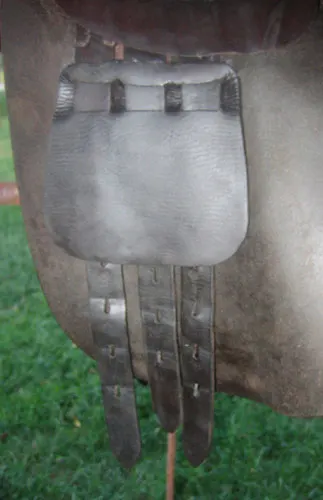
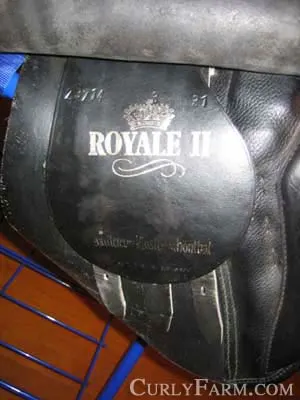
The buckle guard is one place many saddle manufacturers choose to mark their saddles. The saddle shown on the right has the model name and the maker printed on the guard. The top is stamped with the tree size (a number ranging from 27-33, with 31 being average) and a serial number or other manufacturer’s number.
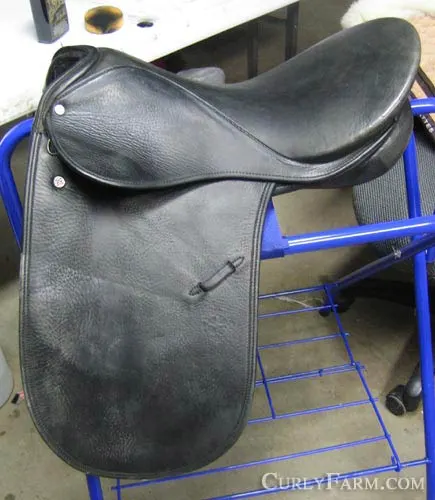
Measuring the width of an English Saddle
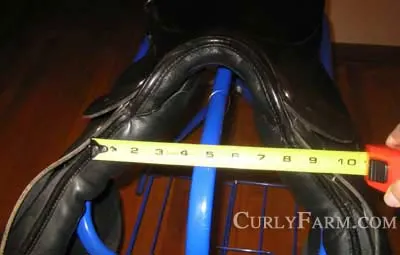
This photo shows an English saddle pictured from the front. The way this saddle is being measured is a somewhat effective method of measuring the width of a saddle you plan to list on eBay or sell online. It is always important to provide accurate measurements for saddles sold online, since many horses require a very specific size.
Before trying to measure the saddle’s width with this method, a better way to determine how wide the tree of a saddle is is to lift the flap on both sides and look for a buckle guard with a maker’s mark stamped on it. If you can find the flap of leather emblazoned with the manufacturer’s name or the model name, there is often a number stamped in a discrete corner of that piece of leather. The number should range from 27-33, with the vast majority of saddles falling in the 30-32 range (31 being “average”)
Underneath an English Saddle: Panels
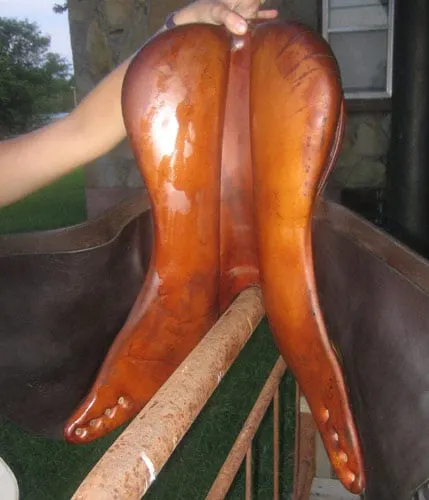
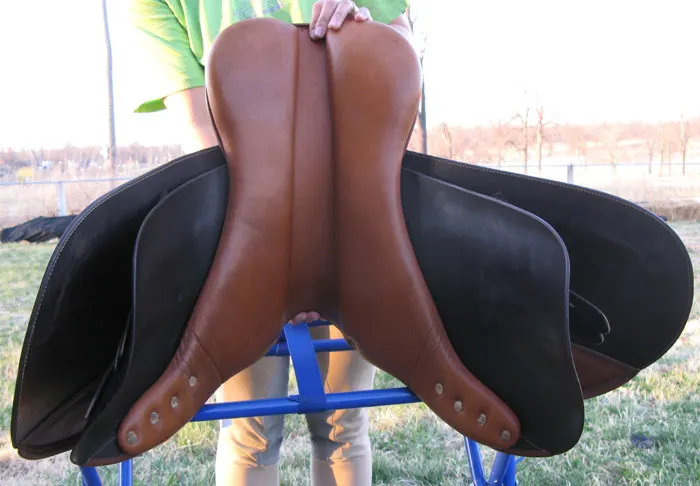
Tese photos show the underside of two English saddles. These padded channels are called panels and should feel firmly stuffed but smooth, not lumpy or overstuffed in some areas and not others. The best saddles are stuffed with pure wool. Cheap saddles are stuffed with newspapers, sawdust, or worse! Recently some saddle companies have created saddles with memory foam panels, but the merits of this material for saddles haven’t yet stood the test of time.
Notice how the new saddle (right) has smooth padding while irregularities are beginning to emerge on the used saddle on the left.
Panel restuffing is a relatively easy fix for most saddle repair shops and buying a saddle in need of panel restuffing may be a good way to find a bargain. Panel restuffing can be done by any tack shop that does repairs on parts of english saddles and typically costs from $75-$200.
Under the Skirt of an English Saddle
This photo shows what is concealed under the “skirt” of an English saddle. The skirt is the piece of leather covering the equipment shown here. When mounted, the skirt is directly under the upper thigh of the rider.
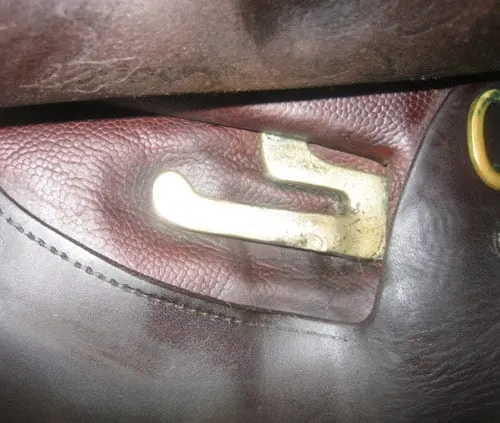
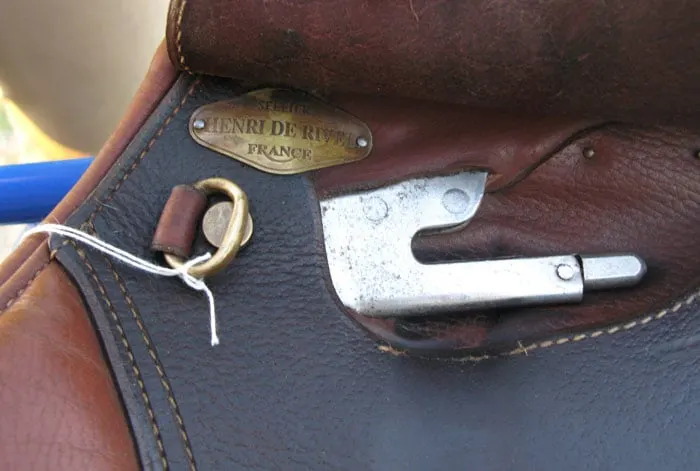
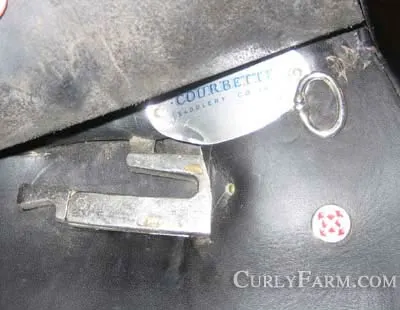
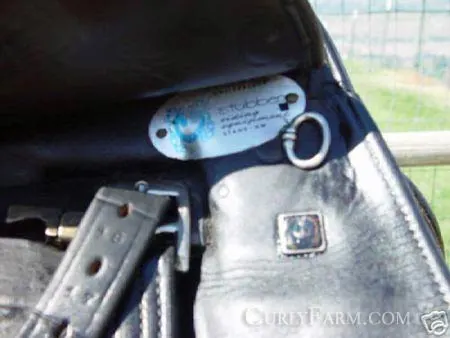
The most important piece of equipment concealed by the skirt is the stirrup bar. The stirrup bar is a solid piece of metal securely anchored to the tree (the “skeleton” of the saddle) and is the bar to which the stirrup leathers attach. At the end of the stirrup bar is a lever which can be left open (as shown) or set in the up position For all activities except eventing, fox hunting, and serious endurance riding, the stirrup bar should be left in the down position.
Left down, this allows the stirrup leather to detach itself from the stirrup bar in the event a rider falls and is drug by a foot caught in the stirrup. However, extreme jumping and climbing hills, can cause a stirrup leather to slip off the bar during the course of the event so for these types of activities the stirrup leather should be left in the up position.
Also under the English saddle’s skirt is a D-ring (where various pieces of auxiliary tack attach), a button (sometimes marked with the saddler’s emblem), and usually a plate identifying the manufacturer. Underneath the skirt of a saddle is the first place to look for a brand name or originating information about a saddle.
There is so much more to learn about saddles and how they fit. Saddles- including billets – are key to humane comunication with our horses.1 This has been a quick introduction but there are many more casual and even academic sources to learn more about the equipment used in English riding.
- Clayton, H. M., Dyson, S., Harris, P., & Bondi, A. (2015). Horses, saddles and riders: Applying the science. Equine Veterinary Education, 27(9), 447-452. [↩]

